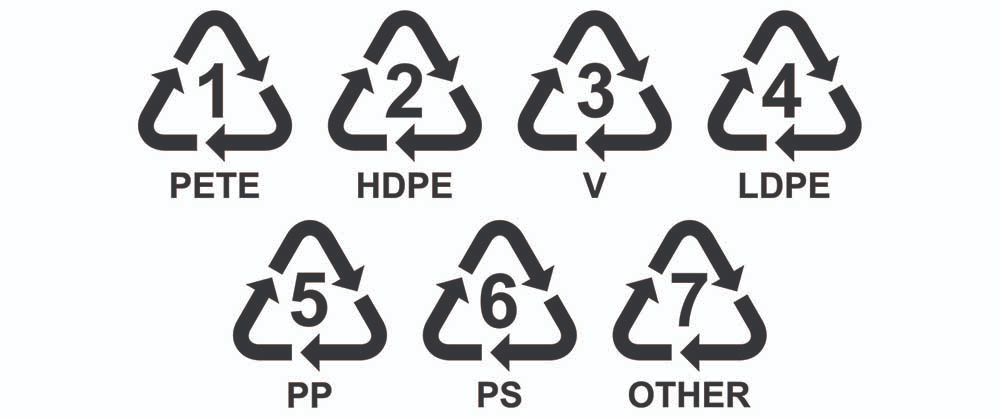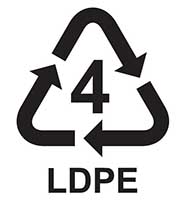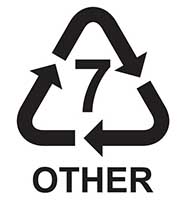In this article, we'll cover:
- Recycle Symbol 1 = PET/PETE (Polyethylene Terephthalate)
- Recycle Symbol 2 = HDPE (High-Density Polyethylene)
- Recycle Symbol 3 = PVC or V (Polyvinyl Chloride)
- Recycle Symbol 4 = LDPE (Low Density Polyethylene)
- Recycle Symbol 5 = PP (Polypropylene)
- Recycle Symbol 6 = PS (Polystyrene)
- Recycle Symbol 7 = OTHER (Various Types)
Also, check out the history of recycling symbols, composting versus recycling, and popular items you think you can recycle but you can't.

Recycle Symbol 1 = PET/PETE (Polyethylene Terephthalate)
Many of the typical plastic items you might be familiar with are made from PET or PETE (polyethylene terephthalate). Extremely common, plastic #1 is lightweight, shatter-resistant and is also the easiest to recycle.
The exceptions are with items like blister packaging and plastic clamshells. A better alternative to those would be compostable clamshell packaging.
PET/PETE (Polyethylene Terephthalate) is commonly used for:
- Water bottles
- Soda bottles
- Juice bottles
- Salad dressing bottles
- Shampoo and conditioner bottles
- Take out food containers
Recycle Symbol 2 = HDPE (High-Density Polyethylene)
Another common and highly recycled plastic is #2, or high-density polyethylene (HDPE). It's very durable and resistant to salt spray, moisture, warping and environmental exposure. It’s widely recycled and accepted by recycling programs in the US.
HDPE (High-Density Polyethylene) is commonly used for:
- Milk jugs
- Detergent bottles
- Outdoor signage
- Grocery bags (which are often only recyclable through drop-off retail locations)
Recycle Symbol 3 = PVC or V (Polyvinyl Chloride)
Plastic #3 refers to resins vinyl (V) and polyvinyl chloride (PVC). Vinyl or PVC is commonly used in making piping, building products like vinyl siding, kids toys, and some household packaging.
This type of plastic is known to contain dangerous additives like lead, cadmium, and phthalates. These make them difficult or sometimes impossible to recycle. They are however very durable and items like kids toys can be easily passed along and reused.
PVC or V (Polyvinyl Chloride) is commonly used for:
- Shower curtains
- Clear food wrap
- Cooking oil bottles
- Kids toys
- Bubble wrap
- Residential and commercial flooring
Recycle Symbol 4 = LDPE (Low Density Polyethylene)
While low weight and very flexible, low-density polyethylene (LDPE) doesn’t have a recycling fate like its counterpart, HDPE. While becoming easier, recycling capabilities for LDPE aren't common.
LDPE (Low Density Polyethylene) is commonly used for:
- Plastic baggies
- Juice boxes
- Squeezable bottles
- Six-pack rings
- Plastic wrap
Recycle Symbol 5 = PP (Polypropylene)
Polypropylene (PP) is one of the most widely used plastics in the world and is commonly recyclable in many major cities and facilities. The tough, heat-resistant material retains its shape regardless of bending and flexing.
PP (Polypropylene) is commonly used for:
- Yogurt containers
- Tupperware
- Food containers
- Bottle caps
- Orange medicine bottles
- Trays
- Luggage
Recycle Symbol 6 = PS (Polystyrene)
Polystyrene (PS), comes in two forms: rigid and foam (Styrofoam). It is based on styrene, which is a neurotoxin and probable carcinogen. It’s also extremely expensive and thus not economically viable to recycle. PS is generally not accepted through curbside or facility recycling services for that reason alone. If possible, reuse items like packing peanuts and reduce your use of this plastic.
PS (Polystyrene) is commonly used for:
- Clear food containers
- Plates, bowls, and utensils
- Car parts
- Insulated beverage cups, bowls, and food trays
- Packing peanuts
- Grocery store meat trays
Recycle Symbol 7 = OTHER (Various Types)
Plastic #7 is used as a catch-all for other types of plastic, including PLA (polylactic acid), which is commercially compostable. The best-known #7 plastics are BPA-containing polycarbonates, nylon, and fiberglass. Regardless of type, this class of plastics is never recycled.
Plastic #7 (Other) is commonly used for:
- Baby bottles
- Water bottle coolers
- Car parts
It’s Time to Recycle the Recycling Symbols
To summarize, what do the recycling numbers mean? In most cases not much. Many people still believe the plastics industry illusion of recyclability through these symbols. Many more are recognizing the failures of these symbols. The broken plastics recycling industry as a whole is paving the way for better alternatives to emerge.
Products like compostable take out containers, cups and lids, and shopping bags are gaining popularity and preference among consumers. Your company can do away with the confusion of the recycling symbols, once and for all by switching to compostables.
For more information, get in touch or check out our compostable products or articles on compostable materials.









